Our research is driven by the view that perception and cognition are tuned to the structure of environments and events. We therefore investigate how attention varies in response to behaviorally relevant moments, how events are perceived and shape memory, and how environmental regularities guide attention over space and time.
Attention to Behaviorally Relevant Moments
How do changes in the relevance of events over time influence the way other information is perceived? To answer this question we ask participants to perform a simple task: Respond to a target item that appears in a stream of distractors (e.g., count the white squares in a stream of black distractor squares) while simultaneously remembering an unrelated stream of images. Because attention is limited, increasing attention to the target should impair memory for coinciding background images. Surprisingly, the data indicate that the opposite occurs: Memory for an image presented at the same time as a target square is better than memory for an image presented with a distractor square (Swallow & Jiang, 2010). Increasing attention to a goal relevant event appears to boost the processing of concurrent information, producing what we have called the attentional boost effect.
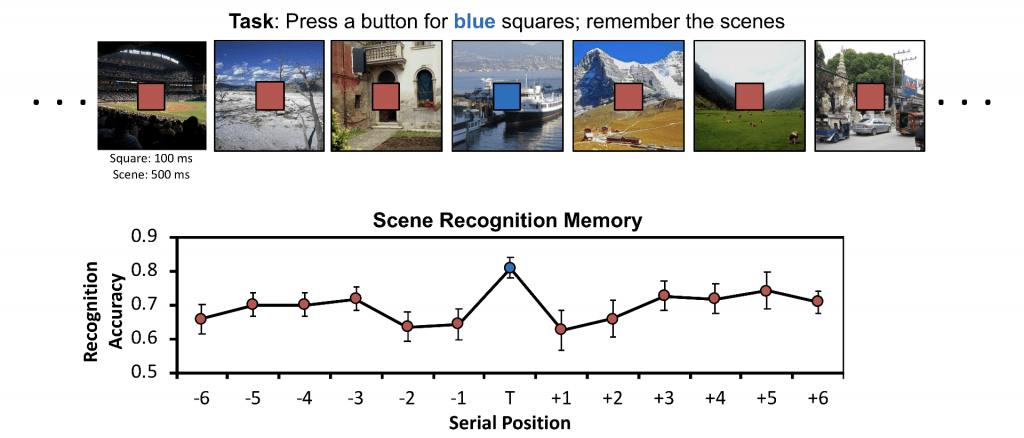
Ongoing research in the lab is investigating the cognitive and neural mechanisms that produce the attentional boost effect, and understanding its implications for how people remember events. We recently found that attending to targets even boosts memory for things that people are ignoring and helps them know which faces appeared with which scene during a particular event (Broitman & Swallow, submitted; Turker & Swallow, 2019).
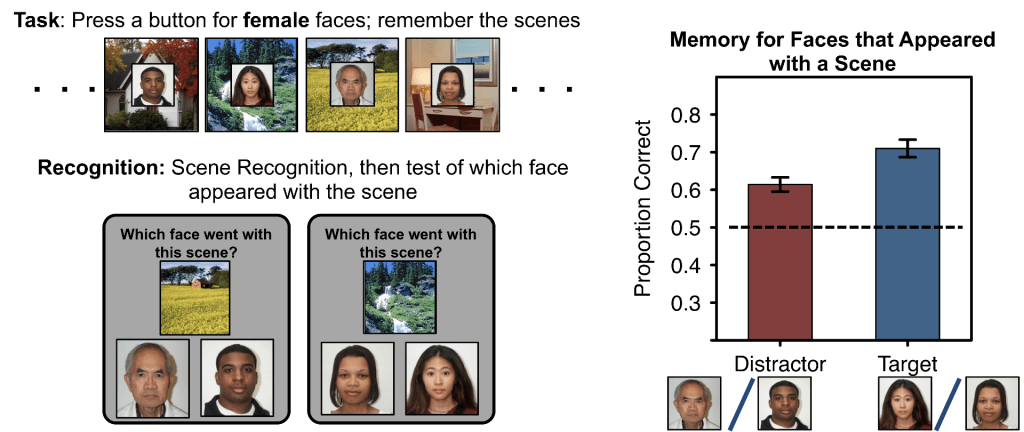
For more information, please see:
- Swallow, K. M. & Jiang, Y. V. (2010). The Attentional Boost Effect: Transient increases in attention to one task enhance performance in a second task. Cognition, 115 (1), 115-132. [PubMed]
- Swallow, K. M., & Jiang, Y. V. (2014). Perceptual load and attentional boost: a study of their interaction. Journal of Experimental Psychology: Human Perception and Performance, 40(3), 1034-1045. [PubMed]
- Turker, H. B., & Swallow, K. M. (2019). Attending to behaviorally relevant moments enhances incidental relational memory. Memory & Cognition, 47, 1-16. [PubMed]
Neural Mechanisms of Temporal Selection
Using MRI, we have found that activity throughout primary visual cortex increases in response to targets (Swallow, Makovski & Jiang, 2012). Surprisingly, this effect occurs even when the targets are auditory tones and there is no new visual information.
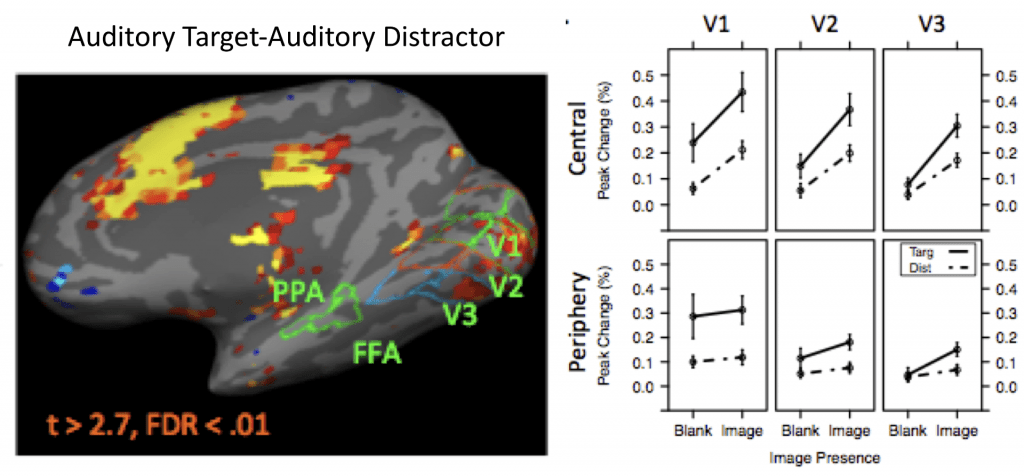
New neuroimaging work is exploring the potential contributions of one neuromodulatory system, originating in the locus coeruleus, to these effects (Turker, et al., submitted).

For more information, please see:
- Swallow, K. M., Makovski, T., & Jiang, Y. V. (2012). The selection of events in time enhances activity throughout early visual cortex. Journal of Neurophysiology, 108 (12), 3239-3252. [PubMed]
- Turker, H. B., Riley, E., Luh, W.-M., Colcombe, S. J., & Swallow, K. M. (submitted). Estimates of locus coeruleus function with functional magnetic resonance imaging are influenced by localization approaches and the use of multi-echo data. BioRxiv, 731620.
Event Segmentation and Memory
In another line of research the lab investigates how people perceive and remember every day events. We ask how people divide their continuous, ongoing experience into meaningful events as they happen. We would like to understand how the moments that separate “What is happening now” from “What just happened” impact when people pay attention to the external world, and what they later remember about it.
We have found that shifts from one event to another influence what information is available for later retrieval and when it can be retrieved from memory (Swallow, Zacks & Abrams, 2009). Trying to remember objects from an event that just ended also increased activity in the medial temporal lobe, including the hippocampus, a part of the brain that is critical for episodic memory (Swallow, et al., 2011).

We also want to account for why people segment when they do. To better understand the contributions of low-level visual features of activities (e.g., visual motion and the actor’s body posture) to segmentation, a recent study asked participants to identify meaningful events in videos of an activity that was filmed from the first-and third-person perspectives. Surprisingly, participants identified similar events across perspectives despite differences in their low-level sensory features (Swallow, Kemp, & Candan Simsek, 2018). In ongoing research, we are looking at whether people are sensitive to different types of changes in other people’s activities, and whether this depends on familiarity with an activity, and the context in which an individual developed.
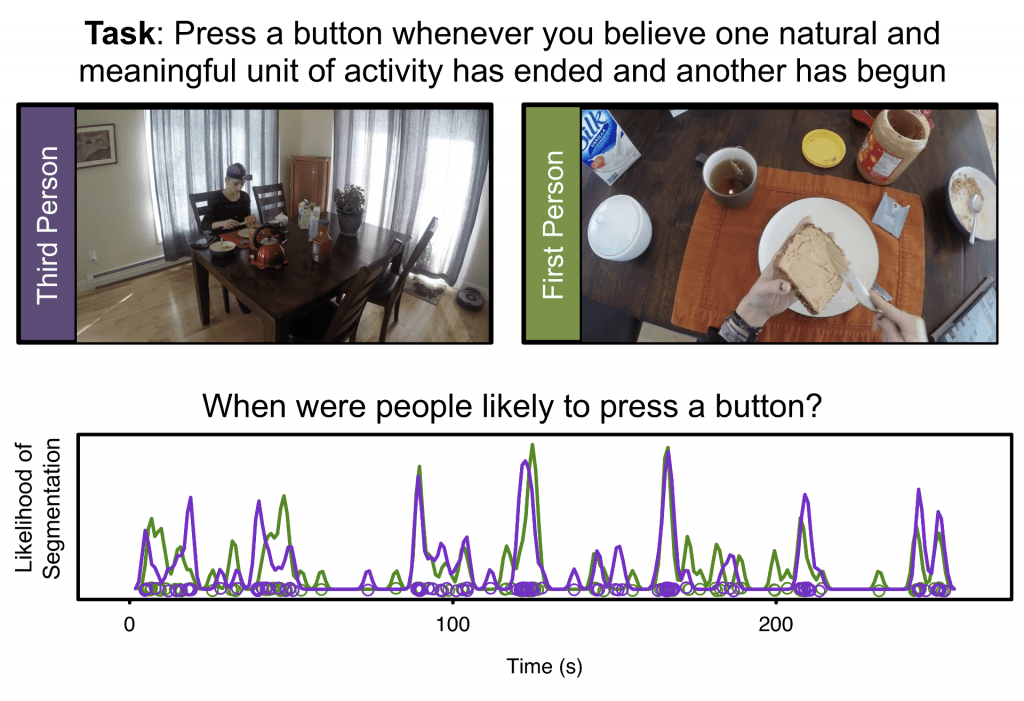
For more information, please see:
- Swallow, K. M., Zacks, J. M., Abrams, R. A., (2009). Event boundaries in perception affect memory encoding and updating. Journal of Experimental Psychology: General, 138(2), 236-257. [PubMed]
- Swallow, K. M., Barch, D. M., Head, D., Maley, C. M., Holder, D., & Zacks, J. M. (2011). Changes in events alter how people remember recent information. Journal of Cognitive Neuroscience, 23 (5), 1052-1064. [PubMed]
- Swallow, K. M., Kemp, J. T. & Candan Simsek, A. (2018). The role of perspective in event segmentation. Cognition, 177, 249-262. [PubMed]
Statistical Learning
How do people learn and use statistical structure in the world to better anticipate goal-relevant events? Our research has shown that people are remarkably sensitive to the statistical structure of activities and can use this information to learn to attend at particular moments in time (Swallow & Zacks, 2008). Our other work has found that people are able to learn which regions of space are likely to contain items that they are searching for (Jiang & Swallow, 2013). However, they tend to learn these locations relative to themselves, rather than as fixed locations in the world. Ongoing research is exploring the relationship between statistical regularities in events and attention.
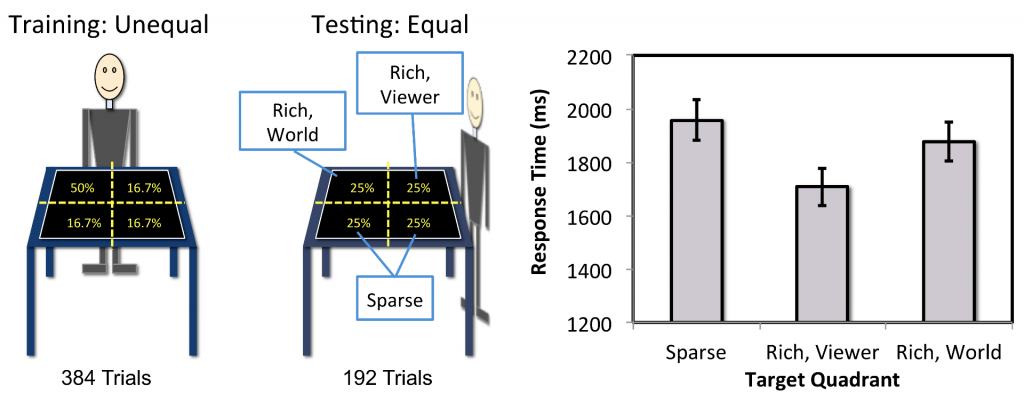
For more information, please see:
- Swallow, K. M., & Zacks, J. M. (2008). Sequences learned without awareness can orient attention during the perception of human activity. Psychonomic Bulletin and Review, 15(1), 116-122. [PubMed]
- Jiang, Y. V., & Swallow, K. M. (2013). The spatial reference frame of incidentally learned attention. Cognition, 126, 378-390. [PubMed]
- Jiang, Y. V., Swallow, K. M., & Sun, L. (2014). Egocentric coding of space for incidentally learned attention: Effects of scene context and task instructions. Journal of Experimental Psychology: Learning, Memory, & Cognition, 40(1), 233-250. [PubMed]